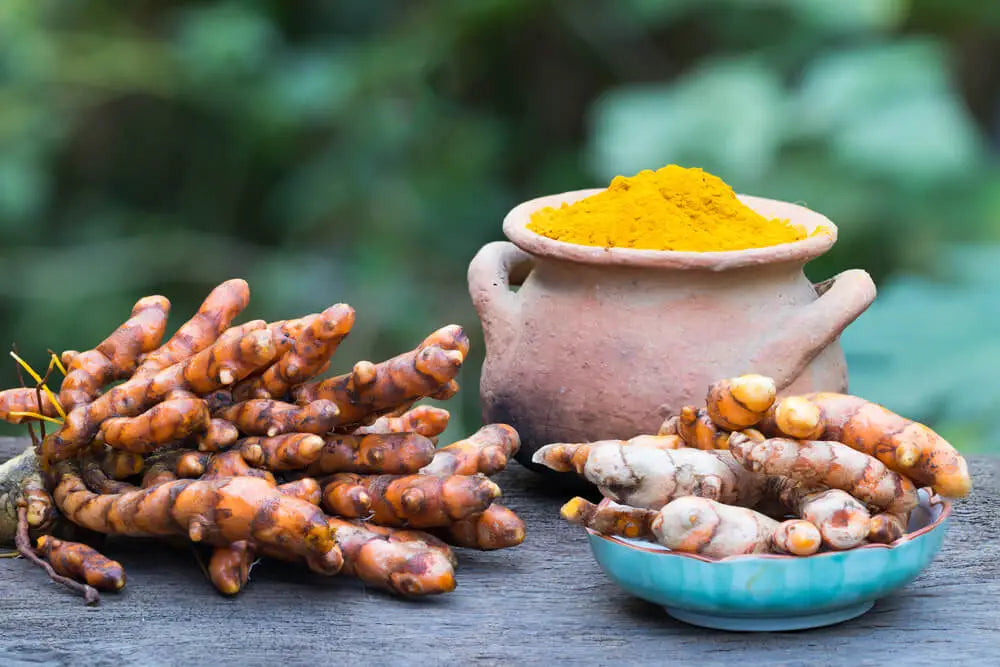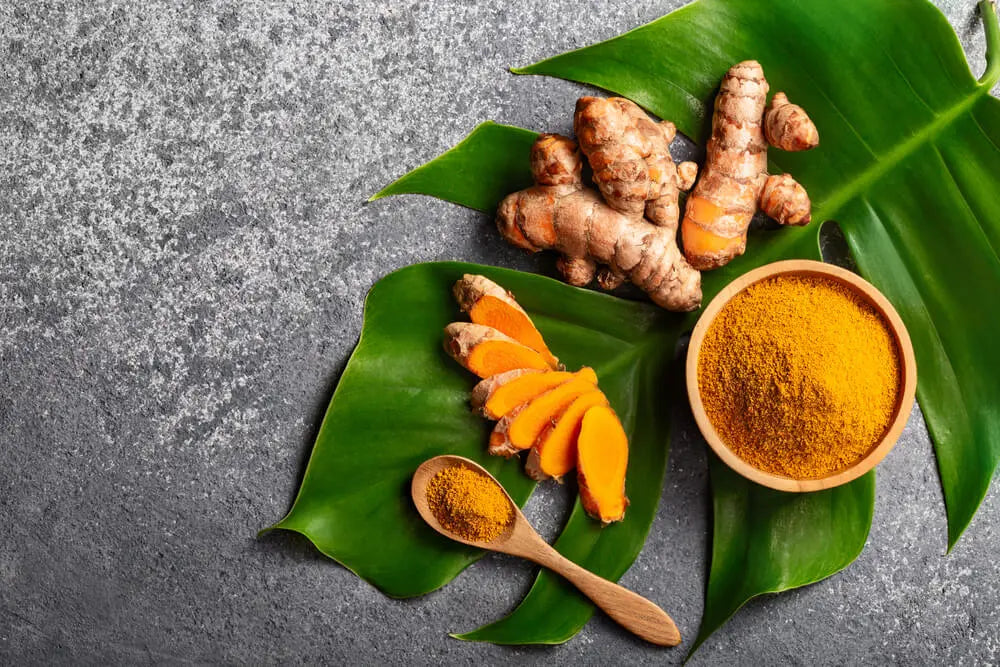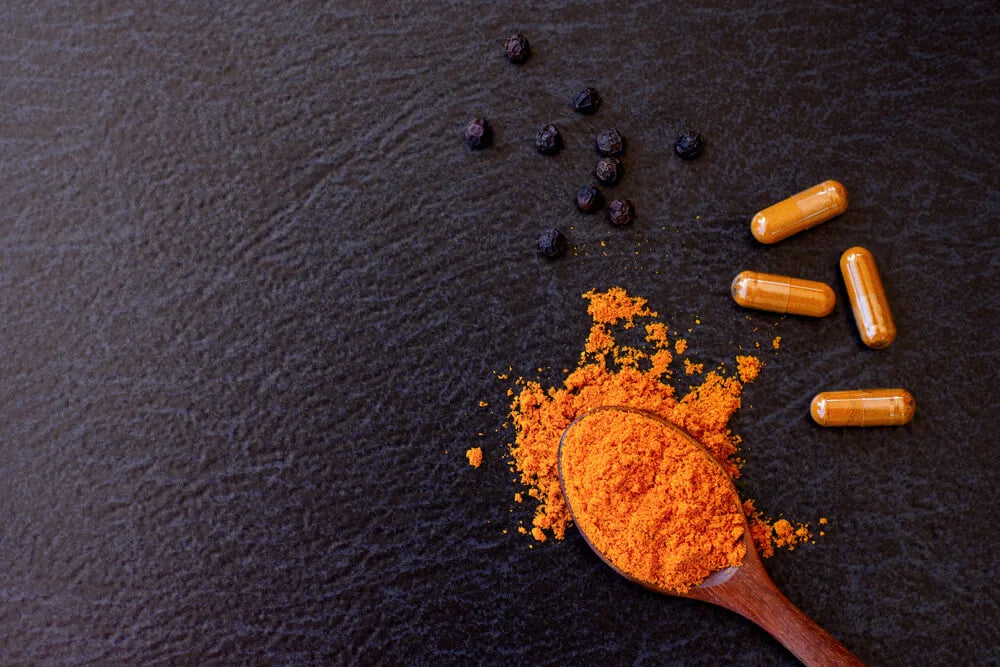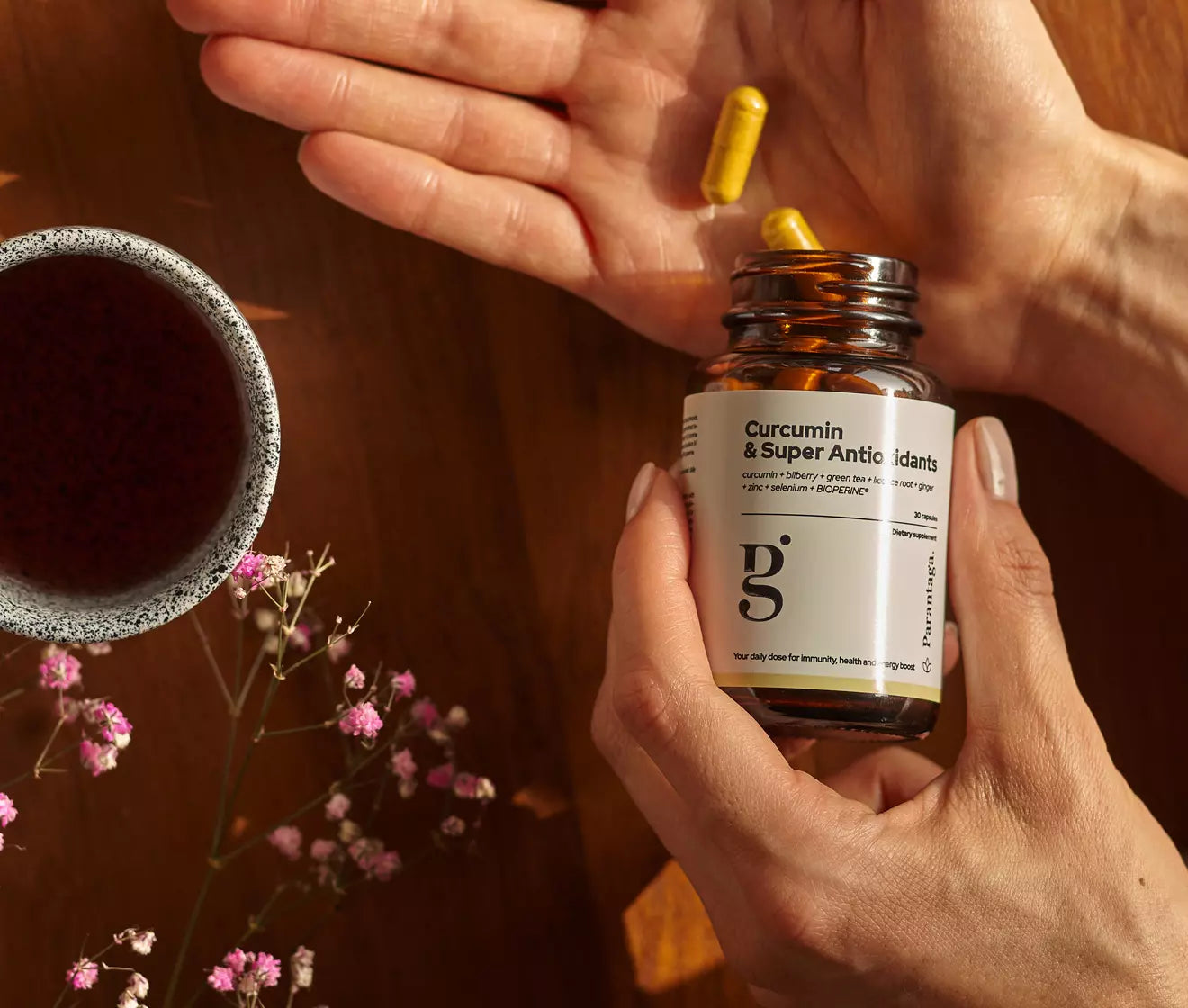Known for millennia for its medicinal and taste values, turmeric (Curcuma longa) is a herbaceous plant from the ginger family. Native to India, this plant is coveted for its underground stems (rhizomes), characterized by a beautiful orange-yellow color. It is used as a spice, pigment, and remedy to fight against numerous diseases. The benefits of turmeric, well recognized in traditional Chinese and Indian medicines, continue to interest researchers around the globe, and are the subject of multiple studies. It is, in fact, the most studied spice in the world! A superfood and an essential ingredient in delicious Indian curries, beauty treatments, and Ayurvedic remedies, turmeric is loaded with vitamins, minerals, enzymes, amino acids, and antioxidants. These valuable nutrients give it multiple therapeutic virtues, particularly a powerful anti-inflammatory action, which can support the treatment of diseases such as arthritis, diabetes, and cancer, or even contribute to slowing down skin aging, soothing irritations, and improving scalp health.

The main active substance in turmeric is curcumin, a pigment from the polyphenol family, which gives turmeric its intense golden color. It accounts for about 2 to 8% of the spice's weight. The benefits of curcumin are firstly linked to its antioxidant power, which helps our cells protect themselves against damage caused by excess free radicals, highly reactive and unstable oxygen molecules that can cause significant harm in our body, such as promoting premature skin aging and inflammatory diseases. Free radicals are naturally produced by our bodies (mainly in the mitochondria, the powerhouses of our cells) and are essential for life, as long as their quantity does not exceed a certain threshold. They are involved in cell communication, help defend against infections, and even eliminate cancer cells. However, beyond this natural production by our bodies, we are now exposed to excessive amounts of free radicals, particularly due to stress, pollution, cigarette smoke, alcohol consumption, unbalanced diet, etc. At the same time, our dietary habits and sedentary lifestyle can deteriorate the functioning of mitochondria, which start to produce more free radicals than they should. To help our bodies protect against this, we can try to limit our exposure to exogenous free radicals, regulate the work of our mitochondria through lifestyle changes, or try to increase the level of endogenous (synthesized by the body) and exogenous (obtained through diet) antioxidants. Ideally, these should come from fruits and vegetables, naturally rich in numerous antioxidants. Unfortunately, soil depletion, excessive use of pesticides, processing of fruits and vegetables, and the way they are stored, reduce their nutritional value and their content in molecules capable of neutralizing free radicals. Hence the interest in supplementing with natural antioxidants whose efficacy has been confirmed by clinical trials.
Curcumin is a very powerful natural antioxidant, with multiple actions and therapeutic effects, the exact mechanism of which is not yet fully elucidated by science. We know today that it can also enhance the action of other complementary antioxidants and anti-inflammatory agents, such as zinc, selenium, or EGCG (the main antioxidant in green tea). It could also raise levels of glutathione, considered the most protective molecule of the human body, indispensable not only for having energy, good mental capabilities, and beautiful skin, but also for protecting against cardiovascular and neurodegenerative diseases. Several studies have demonstrated the therapeutic potential of curcumin in treating patients with chronic diseases such as arthritis, psoriasis, metabolic syndrome, obesity, and Alzheimer's disease, as well as more generally diseases related to the immune system's dysregulation. However, more research is necessary to confirm these results. It is also part of the 'big five' of phytochemical compounds capable of attacking certain types of particularly resistant cancer cells and can significantly increase the anti-cancer effect of other substances. According to a recent study, daily ingestion of bioavailable curcumin improves memory, concentration capacity, and a sense of well-being. Thanks to its antioxidant power, it could also be a natural anti-aging treatment. The excess of free radicals, which causes chronic inflammatory states, is often considered one of the main causes of aging and related diseases.

Unfortunately, curcumin is an unstable molecule that dissolves poorly in water and its absorption by the body is limited. As a result, simply consuming turmeric, even in large doses, does not fully leverage its therapeutic properties: curcumin not only struggles to pass through the intestinal barrier, but it is also rapidly metabolized by the liver and then eliminated by the kidneys, which prevents it from reaching a sufficient concentration in the blood and being distributed in all tissues. There are several methods to overcome this problem: its bioavailability is particularly improved by combining it with another molecule, such as piperine, an alkaloid responsible for the spiciness of black pepper, which helps curcumin pass through the intestinal barrier and stay longer in the bloodstream. Studies have shown that piperine can increase the absorption of curcumin by up to 2000%, thus allowing to better benefit from its multiple effects. We have used this solution in our Curcumin & Super Antioxidants supplement, which contains, among other ingredients, turmeric extract and black pepper extract with 95% piperine.

• Vitamin C, an antioxidant that plays several important roles in the body, necessary among other things for maintaining energy and mental balance (it participates in the production of dopamine and noradrenaline) as well as for the synthesis of collagen (a structural protein omnipresent in the body, for example in bones, cartilages, skin, and gums) and carnitine (a molecule necessary for energy production within each cell, which helps improve cardiac and brain functions);
• Vitamin E, which plays a role in preventing cardiovascular diseases and cancer, as well as in protecting cell membranes, including those of the skin. Therefore, it slows down cell deterioration and the appearance of aging signs. It also encourages tissue regeneration and the treatment of scars;
• Vitamin B3 is necessary for the formation of red blood cells and sexual hormones such as estrogens and testosterone. It contributes to the proper functioning of the digestive tract, including the secretion of bile by the gallbladder, as well as the functioning of the nervous system, notably the production of neurotransmitters. Moreover, it participates in regulating cholesterol levels, and it is involved in the renewal of the epidermis and mucous membranes;
• Vitamin B6, involved in the formation of insulin (which regulates blood sugar levels) and hemoglobin (which transports oxygen from the lungs to the body's tissues), in maintaining hormonal balance, and in the functioning of the immune system.
Turmeric also contains many essential minerals and trace elements for our body:
• Iron, which is part of the structure of hemoglobin, myoglobin (essential for muscle work), and many enzymes, including those involved in DNA synthesis (fresh turmeric contains about 2.5 mg of iron per 100 g of rhizome);
• Zinc, an antioxidant that stimulates immune defenses, improves healing, and maintains healthy skin, hair, and nails (by promoting cell renewal and regulating excess sebum);
• Calcium, the most abundant metallic element in our body, necessary for the formation of bones and teeth, blood clotting, maintaining blood pressure, and muscle contraction;
• Manganese, an antioxidant involved in collagen synthesis, in the metabolism of macronutrients (carbohydrates, lipids, and proteins), and in the construction of bones and joints;
• Phosphorus, which contributes to the ossification of bones, the protection of teeth, and energy production;
• Potassium, necessary for regulating body water and the proper functioning of the nervous system and muscles.
Finally, turmeric is a natural source of cellulose, a dietary fiber that supports intestinal function and nourishes the good bacteria present there. This particularly rich composition makes turmeric a promising health ally, especially in the context of chronic diseases that are difficult to treat today, knowing that further clinical trials are necessary to fully understand its therapeutic potential. Several have already been conclusive. For example, a randomized, placebo-controlled clinical trial on patients suffering from painful knee osteoarthritis showed that daily turmeric extract intake alleviates the symptoms of the disease, these results being based on the evaluation of pain intensity by each patient, the use of relief medications, and a clinical examination of the affected joint. According to a randomized study, a turmeric-based mouthwash reduces bacterial contamination as effectively as chlorhexidine in patients suffering from gum inflammation. Other studies have shown the therapeutic potential of turmeric in cancer treatment, particularly due to its high curcumin content, capable of inducing apoptosis in certain cancer cells and limiting their proliferation. In patients with ulcerative colitis, curcumin, administered in addition to the usual treatment (sulfasalazine or mesalamine), can limit the number of acute disease flares. Daily turmeric ingestion could also lower blood cholesterol levels and thus limit atherosclerosis and contribute to cardiovascular health. Turmeric can also have beneficial effects on the stomach and aid digestion by promoting bile secretion, as well as lower insulin resistance, increase the effects of medications used in diabetes treatment. According to the World Health Organization, turmeric rhizome can be used in the treatment of dyspepsia (digestive disorders such as stomach aches, nausea, loss of appetite, or feelings of heaviness). The curcumin it contains is a non-toxic, well-tolerated antioxidant with many particularly promising biological functions. As such, it continues to be studied so that we can fully understand its therapeutic properties and start using it as a medicine.





